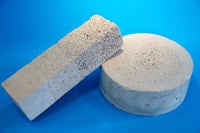 Architect and MIT professor Neri Oxman has been investigating new techniques for applying 3D printing to the science of building construction. We previously wrote of Neri Oxman’s exploits with MaterialEcology, where she leveraged the synergy of computing, ecology, material engineering and design to produce experimental forms.
Architect and MIT professor Neri Oxman has been investigating new techniques for applying 3D printing to the science of building construction. We previously wrote of Neri Oxman’s exploits with MaterialEcology, where she leveraged the synergy of computing, ecology, material engineering and design to produce experimental forms. Now she’s investigating the issue of building materials. Today’s construction materials are “dumb” in that they are totally uniform in composition, since they must be used to solve arbitrary building problems. But what if the building problem was known? What if the building components could be custom made to precisely suit the physical situation it will become part of?
Imagine girders that have strong areas where they need to be strong, and light in other areas – or even sparse sections with no material at all! Every piece could be specifically made to provide the best physical strength for its particular purpose in the building at the least cost of materials. But how would this work?
… input data about physical stresses on a structure, as well as design constraints such as size, overall shape, and the need to let in light into certain areas of a building. Based on this information, the software applies algorithms to specify how the material properties need to change throughout a structure.A load-bearing wall could be printed in elaborate patterns that correspond to the stresses it will experience from the load it supports from wind or earthquakes, for instance.In non-load bearing areas, it could also be possible to print concrete that’s so porous that light can penetrate, or to mix the concrete gradually with transparent materials.
This is a very different approach to applying 3D printing to building construction; other approaches we’ve seen generally involve creating a massive concrete-extruding 3D printer to print an entire building at once. Oxman’s new approach might be more practical and enable the development of radically different structures, since it can be used as much or as little as desired; an entire building could be built using the technique, or simply one advanced beam in a conventional building.


When will I be able to rent a machine? I don't care if the wall is "dumb". Academic stuff is fine, but put it into production.
When will I be able to rent a machine? I don't care if the wall is "dumb". Academic stuff is fine, but put it into production.